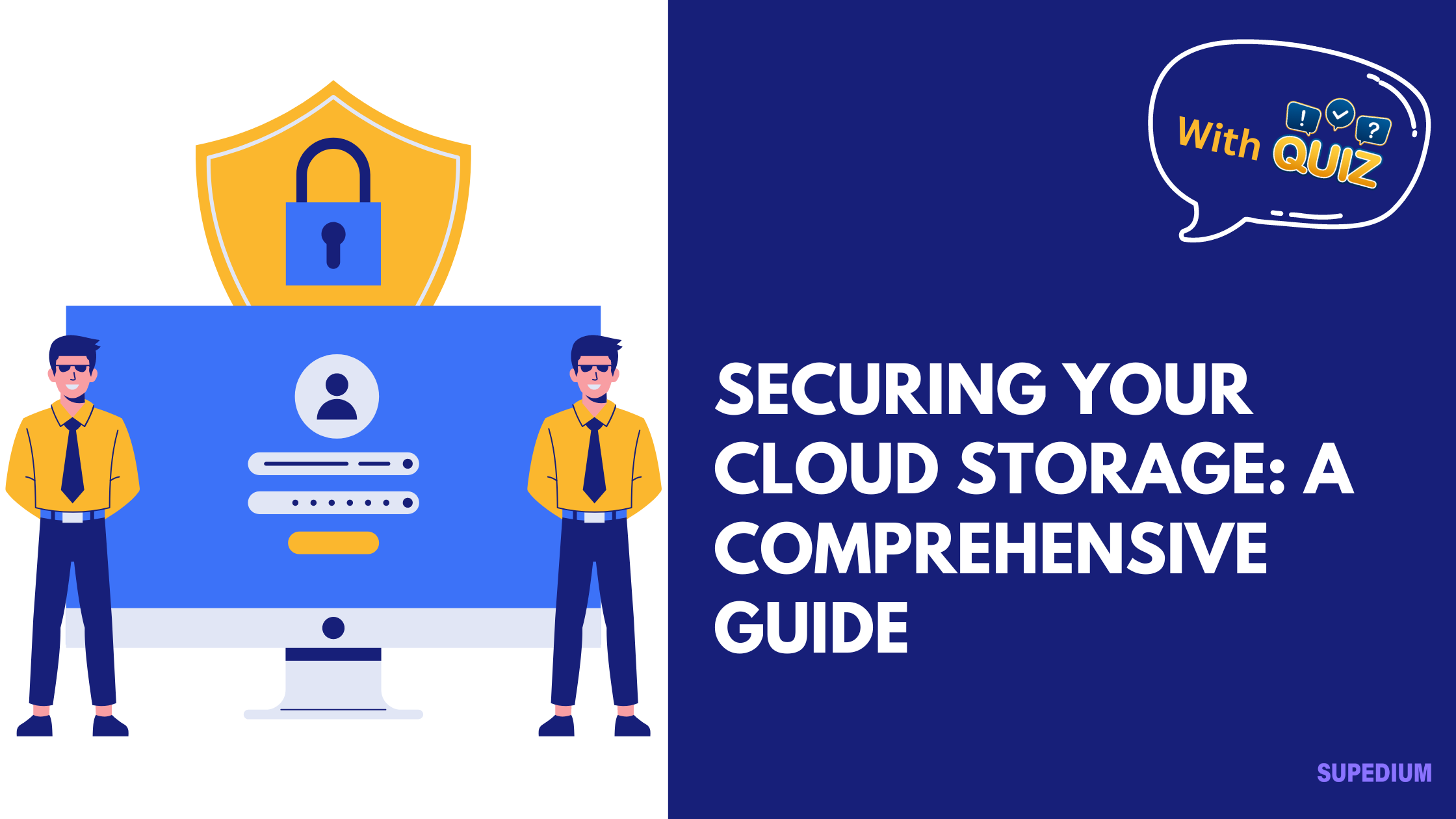Table of Contents
![]()
In today’s digital age, cloud storage has become an indispensable tool for individuals and businesses alike. It offers convenience, scalability, and accessibility, enabling users to store and manage data effortlessly. However, as reliance on cloud services grows, so does the need to ensure that this data remains secure. This article provides a thorough guide to securing your cloud storage, addressing potential risks and outlining best practices to protect your valuable information.
Understanding Cloud Storage Security Risks
Cloud storage involves storing data on remote servers managed by third-party providers. While this setup offers numerous benefits, it also introduces specific risks that users must be aware of:
Data Breaches
Data breaches occur when unauthorized parties gain access to sensitive information. High-profile breaches, such as those involving major tech companies, highlight the severe consequences of inadequate security. A data breach can lead to financial loss, reputational damage, and legal ramifications.
Unauthorized Access
Unauthorized access can result from compromised credentials or internal threats. For instance, if an attacker obtains your login information, they can access your cloud storage and potentially misuse or steal your data. Internal threats, such as disgruntled employees, also pose risks if proper access controls are not in place.
Data Loss
Data loss can occur due to accidental deletion, corruption, or service outages. Although cloud providers generally offer redundancy and backup solutions, data loss is still a risk that must be managed with careful planning.
Compliance and Legal Risks
Regulatory compliance is crucial for businesses storing sensitive data. Regulations such as the General Data Protection Regulation (GDPR) and the Health Insurance Portability and Accountability Act (HIPAA) impose strict requirements on data handling. Non-compliance can result in significant fines and legal consequences.
Best Practices for Securing Cloud Storage
To mitigate these risks, implementing best practices for cloud storage security is essential:
Access Controls
1. Strong Passwords
Creating and managing strong passwords is the first line of defense against unauthorized access. Passwords should be complex, including a mix of letters, numbers, and special characters. Using a password manager can help securely store and generate unique passwords for different accounts.
2. Multi-Factor Authentication (MFA)
MFA adds an extra layer of security by requiring users to provide two or more verification factors to gain access. This could include a combination of something you know (password), something you have (a mobile device or token), and something you are (biometric data). MFA significantly reduces the risk of unauthorized access.
3. Role-Based Access Control (RBAC)
Implementing RBAC ensures that users only have access to the data and resources necessary for their role. This principle of least privilege minimizes the risk of accidental or malicious data exposure. Regularly reviewing and updating user permissions is crucial for maintaining security.
Encryption
1. Data Encryption in Transit
Encryption in transit protects data as it travels over networks. Using protocols such as SSL/TLS ensures that data transferred between your device and the cloud provider’s servers is encrypted and secure from interception.
2. Data Encryption at Rest
Encryption at rest secures data stored on servers. Employing strong encryption standards like AES (Advanced Encryption Standard) ensures that your data remains protected even if an attacker gains physical access to the storage infrastructure.
3. End-to-End Encryption
End-to-end encryption ensures that data is encrypted on the sender’s side and only decrypted on the recipient’s side. This approach prevents cloud providers and unauthorized third parties from accessing the unencrypted data, enhancing overall security.
Backup and Recovery
1. Regular Backups
Regularly backing up data is crucial for mitigating the risk of data loss. Backups should be performed at frequent intervals and stored in multiple locations (both cloud and local) to ensure data redundancy and availability.
2. Data Recovery Plans
Developing and testing data recovery plans are essential for ensuring that you can quickly restore data in the event of loss or corruption. A well-documented and tested recovery plan minimizes downtime and operational disruption.
Monitoring and Auditing
1. Activity Logs
Maintaining and reviewing activity logs helps track access and changes to your data. Analyzing logs can identify unusual or unauthorized activities, enabling prompt response to potential security incidents.
2. Security Audits
Conducting regular security audits helps identify vulnerabilities and assess the effectiveness of your security measures. Engaging third-party security experts can provide an objective evaluation and recommendations for improvement.
Secure Configuration
1. Default Settings
Review and update default settings provided by cloud services. Default configurations often prioritize convenience over security, so customizing settings to align with security best practices is necessary.
2. Security Patches and Updates
Keeping software and applications up-to-date is vital for addressing known vulnerabilities. Regularly applying security patches and updates ensures that your systems are protected against emerging threats.
3. Network Security
Configuring firewalls and intrusion detection systems (IDS) enhances network security. These measures help detect and prevent unauthorized access and cyberattacks targeting your cloud storage infrastructure.
Cloud Storage Provider Considerations
Choosing the right cloud storage provider is crucial for maintaining data security:
Evaluating Providers
1. Security Certifications
Look for providers with recognized security certifications, such as ISO 27001 or SOC 2. These certifications indicate that the provider adheres to industry-standard security practices.
2. Service-Level Agreements (SLAs)
Review the provider’s SLA to understand their security and uptime guarantees. SLAs should outline the provider’s responsibilities regarding data protection and service reliability.
3. Data Center Security
Evaluate the physical security measures of the provider’s data centers. This includes access controls, surveillance, and environmental safeguards to protect against physical threats.
Compliance and Legal Aspects
1. Data Location and Jurisdiction
Understand where your data is stored and the legal implications of that location. Different jurisdictions may have varying regulations and protections.
2. Provider’s Compliance with Regulations
Ensure that the provider complies with relevant regulations, such as GDPR or HIPAA. Compliance helps mitigate legal risks and ensures that your data is handled in accordance with applicable laws.
User Education and Awareness
1. Training for Users
Regular security training for employees and users is essential for reducing the risk of human error. Training should cover topics such as phishing, social engineering, and safe data handling practices.
2. Developing Security Policies
Create and enforce organizational security policies that outline acceptable use, data handling procedures, and response protocols for security incidents. Regularly update these policies to reflect new threats and technologies.
Emerging Trends and Technologies
1. Zero Trust Architecture
Zero Trust Architecture operates on the principle of never trusting, always verifying. This approach involves continuously validating users and devices before granting access, regardless of their location.
2. AI and Machine Learning
Artificial Intelligence (AI) and Machine Learning (ML) are increasingly used to enhance cloud storage security. These technologies can detect anomalies, predict threats, and respond to incidents in real-time.
3. Blockchain Technology
Blockchain technology offers potential applications for enhancing cloud storage security, such as decentralized data verification and tamper-proof records.
Conclusion
Securing cloud storage is a multifaceted challenge that requires a proactive and comprehensive approach. By understanding the risks, implementing best practices, and choosing the right providers, you can significantly enhance the security of your cloud-stored data. Stay informed about emerging trends and continuously adapt your security measures to safeguard your information against evolving threats.






Be the first to comment